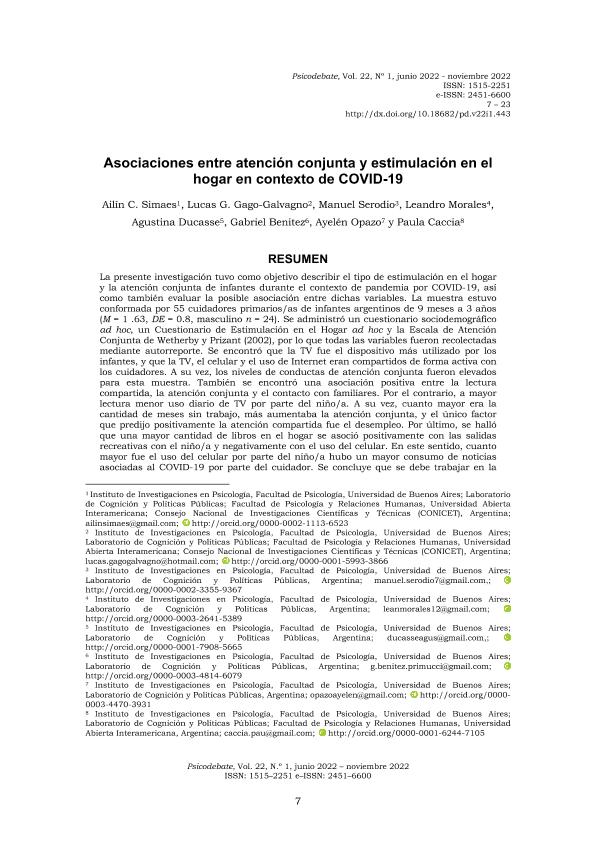Mostrar el registro sencillo del ítem
dc.contributor.author
Simaes, Ailin Charo

dc.contributor.author
Gago Galvagno, Lucas Gustavo

dc.contributor.author
Serodio, Manuel

dc.contributor.author
Morales, Leandro
dc.contributor.author
Ducasse, Agustina
dc.contributor.author
Benítez, Gabriel
dc.contributor.author
Opazo, Ayelén
dc.contributor.author
Caccia, Paula Agustina

dc.date.available
2022-07-04T19:02:23Z
dc.date.issued
2022-06
dc.identifier.citation
Simaes, Ailin Charo; Gago Galvagno, Lucas Gustavo; Serodio, Manuel; Morales, Leandro; Ducasse, Agustina; et al.; Asociaciones entre atención conjunta y estimulación en el hogar en contexto de COVID-19; Universidad de Palermo; Psicodebate; 22; 1; 6-2022; 7-23
dc.identifier.issn
1515-2251
dc.identifier.uri
http://hdl.handle.net/11336/161214
dc.description.abstract
La presente investigación tuvo como objetivo describir el tipo de estimulación en el hogar y la atención conjunta de infantes durante el contexto de pandemia por COVID-19, así como también evaluar la posible asociación entre dichas variables. La muestra estuvo conformada por 55 cuidadores primarios/as de infantes argentinos de 9 meses a 3 años (M = 1 .63, DE = 0.8, masculino n = 24). Se administró un cuestionario sociodemográfico ad hoc, un Cuestionario de Estimulación en el Hogar ad hoc y la Escala de Atención Conjunta de Wetherby y Prizant (2002), por lo que todas las variables fueron recolectadas mediante autorreporte. Se encontró que la TV fue el dispositivo más utilizado por los infantes, y que la TV, el celular y el uso de Internet eran compartidos de forma activa con los cuidadores. A su vez, los niveles de conductas de atención conjunta fueron elevados para esta muestra. También se encontró una asociación positiva entre la lectura compartida, la atención conjunta y el contacto con familiares. Por el contrario, a mayor lectura menor uso diario de TV por parte del niño/a. A su vez, cuanto mayor era la cantidad de meses sin trabajo, más aumentaba la atención conjunta, y el único factor que predijo positivamente la atención compartida fue el desempleo. Por último, se halló que una mayor cantidad de libros en el hogar se asoció positivamente con las salidas recreativas con el niño/a y negativamente con el uso del celular. En este sentido, cuanto mayor fue el uso del celular por parte del niño/a hubo un mayor consumo de noticias asociadas al COVID-19 por parte del cuidador. Se concluye que se debe trabajar en la cantidad de tiempo que los infantes están expuestos a dispositivos tecnológicos y promover espacios de atención conjunta, tales como la lectura compartida en los primeros años del desarrollo.
dc.description.abstract
The objective of this research was to describe the type of stimulation at home and the joint attention of infants during the context of the COVID-19 pandemic, as well as to evaluate the possible association between these variables. The sample consisted of 55 primary caregivers of Argentine infants aged 9 months to 3 years (M = 1.63, SD = 0.8, male n = 24). An ad hoc sociodemographic questionnaire, an ad hoc Home Stimulation Questionnaire and the Joint Attention Scale of Wetherby and Prizant (2002) were administered, for which all variables were collected by self-report. It was found that the TV was the device most used by infants, and that TV, cell phone, and Internet use were actively shared with caregivers. In turn, the levels of joint attention behaviors were high for this sample. A positive association was also found between shared reading, joint attention and contact with relatives. On the contrary, the more reading, the less daily TV use by the child. In turn, it was found that high number of months out of work, were associated to high levels of joint attention, and the only factor that positively predicted joint attention was unemployment. Finally, it was found that a greater number of books in the home was positively associated with recreational activities with the child and negatively associated with cell phone use. In this sense, a higher level of cell phone use by the child was associated with a greater consumption of news associated with COVID19 by the caregiver. It is concluded that it is necessary to work on the amount of time that infants are exposed to technological devices and promote joint attention spaces, such as shared reading in the early years of development.
dc.format
application/pdf
dc.language.iso
spa
dc.publisher
Universidad de Palermo
dc.rights
info:eu-repo/semantics/openAccess
dc.rights.uri
https://creativecommons.org/licenses/by/2.5/ar/
dc.subject
ESTIMULACIÓN EN EL HOGAR
dc.subject
ATENCIÓN CONJUNTA
dc.subject
INFANTES
dc.subject
COVID-19
dc.subject.classification
Otras Psicología

dc.subject.classification
Psicología

dc.subject.classification
CIENCIAS SOCIALES

dc.title
Asociaciones entre atención conjunta y estimulación en el hogar en contexto de COVID-19
dc.title
Associations between joint attention and home stimulation in the context of COVID-19
dc.type
info:eu-repo/semantics/article
dc.type
info:ar-repo/semantics/artículo
dc.type
info:eu-repo/semantics/publishedVersion
dc.date.updated
2022-06-30T19:01:50Z
dc.identifier.eissn
2451-6600
dc.journal.volume
22
dc.journal.number
1
dc.journal.pagination
7-23
dc.journal.pais
Argentina

dc.journal.ciudad
Ciudad Autónoma de Buenos Aires
dc.description.fil
Fil: Simaes, Ailin Charo. Consejo Nacional de Investigaciones Científicas y Técnicas; Argentina. Universidad de Buenos Aires. Facultad de Psicología. Instituto de Investigaciones; Argentina. Universidad Abierta Interamericana. Facultad de Psicología; Argentina
dc.description.fil
Fil: Gago Galvagno, Lucas Gustavo. Consejo Nacional de Investigaciones Científicas y Técnicas; Argentina. Universidad de Buenos Aires. Facultad de Psicología. Instituto de Investigaciones; Argentina. Universidad Abierta Interamericana. Facultad de Psicología; Argentina
dc.description.fil
Fil: Serodio, Manuel. Consejo Nacional de Investigaciones Científicas y Técnicas; Argentina. Universidad de Buenos Aires. Facultad de Psicología. Instituto de Investigaciones; Argentina
dc.description.fil
Fil: Morales, Leandro. Universidad de Buenos Aires. Facultad de Psicología. Instituto de Investigaciones; Argentina
dc.description.fil
Fil: Ducasse, Agustina. Universidad de Buenos Aires. Facultad de Psicología. Instituto de Investigaciones; Argentina
dc.description.fil
Fil: Benítez, Gabriel. Universidad de Buenos Aires. Facultad de Psicología. Instituto de Investigaciones; Argentina
dc.description.fil
Fil: Opazo, Ayelén. Universidad de Buenos Aires. Facultad de Psicología. Instituto de Investigaciones; Argentina
dc.description.fil
Fil: Caccia, Paula Agustina. Universidad Abierta Interamericana. Facultad de Psicología; Argentina. Universidad de Buenos Aires. Facultad de Psicología. Instituto de Investigaciones; Argentina
dc.journal.title
Psicodebate
dc.relation.alternativeid
info:eu-repo/semantics/altIdentifier/url/https://dspace.palermo.edu/ojs/index.php/psicodebate/article/view/4438
dc.relation.alternativeid
info:eu-repo/semantics/altIdentifier/doi/https://doi.org/10.18682/pd.v22i1.4438
Archivos asociados
